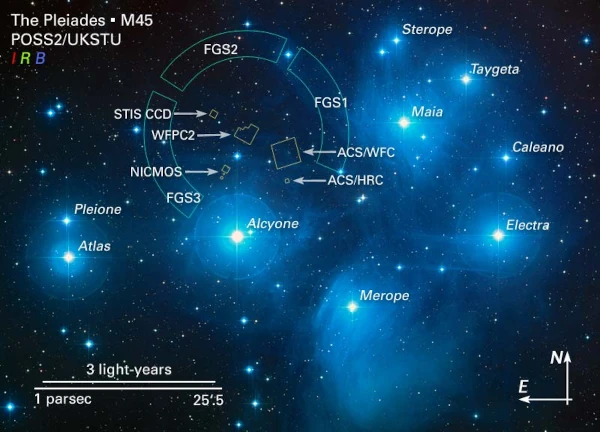
The Pleiades, also known as Messier 45 (M45), form one of the brightest and closest open clusters to Earth. Located in the constellation Taurus about 444 light-years away, they consist of several hundred gravitationally bound stars, of which only a handful are visible to the naked eye.
N.B.:
An open cluster is a grouping of stars physically bound together by gravity, which formed simultaneously from the same giant molecular cloud.
The Pleiades cluster is young, with an estimated age of about 100 million years. It formed from a giant molecular cloud. The main stars are of spectral type B, very hot and luminous, and show a bluish halo when observed through a telescope.
N.B.:
The spectral type B is a stellar classification that designates very hot, massive, blue, and luminous stars. This classification groups stars according to their light spectrum, directly related to the effective temperature of their photosphere.
In Greek mythology, the Pleiades represent the seven daughters of Atlas and Pleione: Maia, Electra, Taygete, Alcyone, Celaeno, Sterope, and Merope. These names are also given to the brightest stars in the group, although six are easily visible to the naked eye, with the seventh (Merope) being fainter. The name "Pleiades" itself evokes this celestial sibling.
Contrary to popular belief, the dust visible around the Pleiades is not the remnants of the cloud that gave birth to them, but the residue of an interstellar cloud that the cluster is currently passing through. This dust reflects the blue light of the stars, producing a reflection nebula particularly visible around Merope.
N.B.:
A reflection nebula is a type of nebula consisting of interstellar dust that reflects the light of nearby stars, without being hot enough to emit its own light.
The Pleiades will eventually disperse over millions of years due to internal and external gravitational interactions. This typical process of open clusters makes them unstable on the scale of a billion years. Some of their stars will then join the galactic stellar field.
| Mythological Name | Designation | Apparent Magnitude | Spectral Type | Radius (in \( R_{\odot} \)) | Lifespan (Ma) |
|---|---|---|---|---|---|
| Alcyone | η Tauri | 2.87 | B7IIIe | 6.1 | 220 |
| Maia | 20 Tauri | 3.87 | B8III | 5.4 | 250 |
| Electra | 17 Tauri | 3.70 | B6III | 5.9 | 190 |
| Merope | 23 Tauri | 4.18 | B6IVev | 5.2 | 200 |
| Taygete | 19 Tauri | 4.29 | B6V | 3.5 | 250 |
| Celaeno | 16 Tauri | 5.45 | B7IV | 3.1 | 280 |
| Sterope | Asterope I & II | 5.76 | B8V | 2.8 | 350 |
Sources: SIMBAD, Gaia Archive, main sequence stellar models (Padova, Geneva, MIST).
The Pleiades are one of the oldest observed and documented star clusters by human civilizations. Their visibility to the naked eye, their compact alignment, and their aesthetic appearance have made them central in many cultures. Their mention is found in astronomical and mythological texts from antiquity.
The Mesopotamians referred to them as Mul.MUL, the "cluster of stars," as early as the 2nd millennium BC. In ancient Greece, they appear in the writings of Homer and Hesiod, particularly in The Works and Days, where their heliacal rising and setting served as markers for agricultural cycles.
In Chinese culture, the Pleiades belong to the asterism of the "Hairs of the Western Woman" (昴 mǎo), a seasonal marker used in ancient lunisolar calendars. Among the Maori of New Zealand, they are known as Matariki and mark the beginning of the new year.
In Western astronomy, Galileo was the first to observe the Pleiades through a telescope in the 17th century. He drew a map revealing more than 30 stars invisible to the naked eye. Later, Charles Messier recorded them as number 45 in his catalog (M45), although they are not cometary objects. At the end of the 19th century, Edward Charles Pickering highlighted their typical spectrum of hot stars.
It was not until the 20th century, with modern photography and spectroscopy, that their true nature was understood: an open cluster of young stars, formed in a giant molecular cloud. Space missions such as Hipparcos, and later Gaia, have since allowed precise measurements of their distances, proper motions, and internal structures.
Even today, the Pleiades play a fundamental role in the calibration of stellar evolution models. Their proximity (about 444 light-years) and youth (100 Ma) make them a privileged celestial laboratory for understanding the formation and dynamics of open clusters.
| Culture | Local Name | Significance / Usage | Era |
|---|---|---|---|
| Mesopotamian | Mul.MUL | Collective name for "star cluster"; agricultural calendar | ~2000 BC |
| Greek | Πλειάδες (Pleiádes) | Seven mythological sisters, agricultural and maritime markers | ~700 BC |
| Chinese | 昴 (Mǎo) | Seasonal asterism, part of the Chinese zodiac | ~1000 BC |
| Japan | 昴 (Subaru) | Modern name, symbol of unity and harmony | Antiquity to today |
| Māori (New Zealand) | Matariki | Marks the lunar New Year; ritual celebration | Millennial oral tradition |
| Native American (Navajo, Lakota...) | Various names | Spiritual symbols, legends of hunters or young girls | Ancestral traditions |
| Arab | Al-Thurayya | Reference in poetry and navigation | Middle Ages |
| Modern European | Pleiades / M45 | Messier catalog; telescopic observations | 17th century to today |